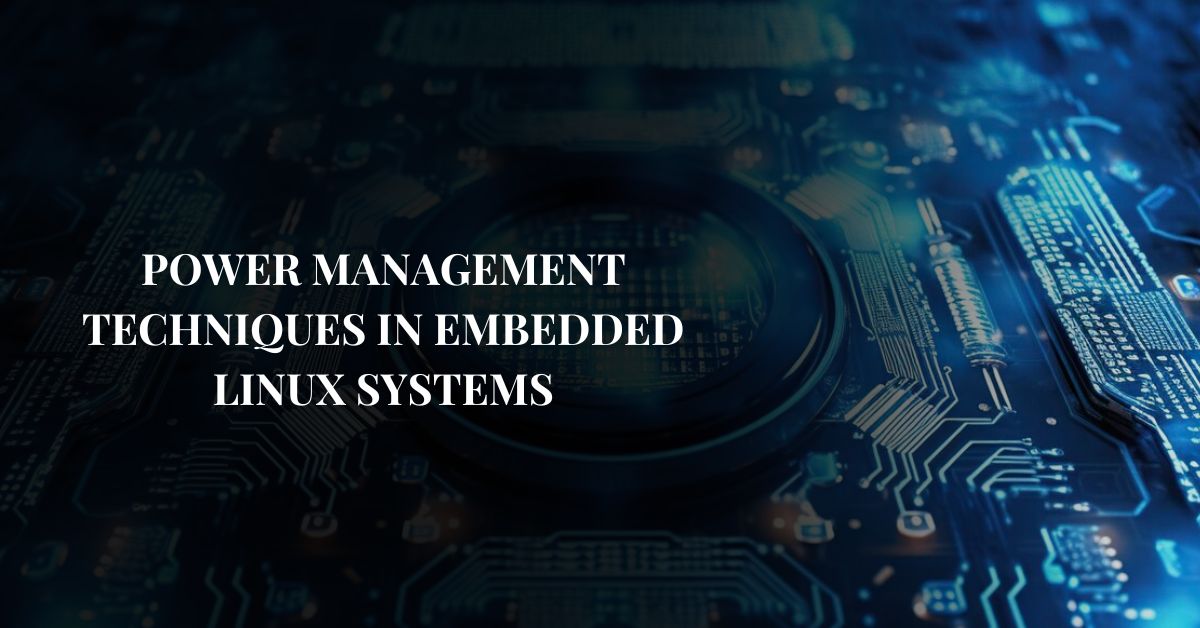In today’s technology-driven world, power management has become a crucial aspect of embedded system design, especially in battery-powered and energy-constrained environments such as IoT devices, wearable technology, and portable medical equipment. Efficient power management ensures prolonged battery life, reduces energy consumption, and enhances the overall performance of embedded systems. Embedded Linux, with its rich set of features and flexibility, offers various techniques and tools for effective power management. Additionally, embedded Linux development services can help tailor power management solutions to specific project requirements, ensuring optimal efficiency and performance. This article delves into the essential power management techniques in embedded Linux systems.
Understanding Power Management in Embedded Linux
Power management in embedded systems involves controlling and optimizing the power consumption of both the hardware and software components. Embedded Linux systems use a combination of hardware features, kernel mechanisms, and user-space tools to achieve this optimization. The primary goals of power management in embedded systems are to minimize power consumption during idle periods, manage active power consumption efficiently, and ensure the system can respond quickly to power state changes.
Key Power Management Techniques
-
Dynamic Voltage and Frequency Scaling (DVFS)
DVFS is a technique that adjusts the processor’s voltage and frequency according to the workload requirements. By reducing the voltage and frequency during periods of low activity, the system can significantly lower power consumption. Embedded Linux supports DVFS through kernel governors, such as ondemand, conservative, and schedutil, which dynamically adjust the CPU frequency based on system load.
-
CPU Idle States
Modern processors have various idle states (C-states) that allow them to reduce power consumption when the CPU is idle. The deeper the C-state, the less power the CPU consumes, but the longer it takes to return to an active state. Embedded Linux uses the cpuidle subsystem to manage these states. Developers can optimize power consumption by selecting appropriate idle states based on the system’s performance requirements.
-
Power Management Integrated Circuits (PMICs)
PMICs are specialized hardware components designed to manage power in embedded systems. They control power distribution, voltage regulation, and power sequencing for different components. Embedded Linux can interface with PMICs through device drivers, allowing the operating system to control power states and transitions effectively.
-
Dynamic Power Management (DPM)
DPM involves dynamically adjusting the power states of various components based on their usage. Components such as GPUs, Wi-Fi modules, and peripheral devices can be put into low-power states when not in use. Embedded Linux provides frameworks like Runtime PM and Device Tree to facilitate dynamic power management of peripherals.
-
System Suspend and Resume
Suspending the entire system to a low-power state (such as suspend-to-RAM or suspend-to-disk) during periods of inactivity can save significant power. In suspend-to-RAM, the system state is stored in RAM, allowing for quick resume times, while suspend-to-disk saves the state to non-volatile storage, enabling deeper power savings at the cost of longer resume times. The Linux kernel supports various suspend modes, which can be configured based on the application’s needs.
Implementing Power Management in Embedded Linux
To effectively implement power management in embedded Linux systems, developers must consider both software and hardware aspects. Here are some steps to guide the process:
-
Analyze Power Requirements
Understanding the power requirements of the system is the first step. This involves identifying the power-hungry components and understanding their usage patterns. Tools like powertop can help analyze power consumption and identify areas for optimization.
-
Configure Kernel Parameters
Configuring the Linux kernel with appropriate power management settings is crucial. This includes enabling CPU frequency scaling, configuring idle states, and selecting the right governors. Kernel parameters can be set during the build process or modified at runtime using tools like cpufrequtils.
-
Optimize Device Drivers
Ensuring that device drivers support power management features is essential. Drivers should be capable of handling suspend and resume operations, supporting runtime power management, and interfacing with PMICs. Developers may need to modify or write custom drivers to achieve optimal power management.
-
Utilize User-Space Tools
User-space tools and daemons, such as systemd, pm-utils, and upower, provide mechanisms to control power management policies and handle suspend/resume operations. These tools can automate power management tasks and enforce policies based on user preferences and system state.
-
Implement Application-Level Power Management
Applications running on the embedded system can also contribute to power management. By implementing efficient coding practices, optimizing algorithms, and reducing unnecessary processing, applications can minimize their power footprint. Additionally, applications can interact with power management APIs to signal idle states and respond to power events.
Conclusion
Effective power management is essential for the longevity and performance of embedded Linux systems. By leveraging techniques such as DVFS, CPU idle states, PMICs, DPM, and system suspend/resume, developers can optimize power consumption and ensure reliable operation in energy-constrained environments. Embedded Linux, with its robust support for power management, provides the tools and frameworks necessary to implement these techniques. By following best practices and utilizing both hardware and software capabilities, developers can create power-efficient embedded systems that meet the demands of modern applications. Embedded software development services play a critical role in this process by offering expertise in optimizing power management algorithms and integrating them seamlessly into embedded Linux applications.





